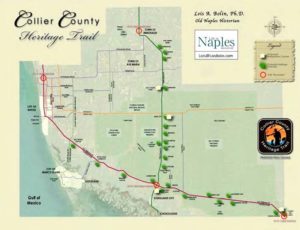Mission Possible: 2020 Staycation Memories

Lois Bolin, PhD, Old Naples Historian
History is not a burden of the memory but an illumination of the soul. Lord Acton
Summertime and the living is easy unless you have just been through months of school closings and job uncertainty. Some things still hold certain – like how much kids can eat while home bound and summer vacation anticipations. Yes, somethings never change.
Throughout my 40 plus years in Naples, I have heard many complaints on how much our community has changed. But what if their families came here in the late 1890s? Oh, the stories they could tell and it’s these stories that may hold the key to your 2020 staycation memories.
Mission Possible
(Note the clues in Bold Black.) Charles Tebeau a prominent Florida historian, wrote that Collier County was a part of Florida’s and (America’s) final frontier, with settlements all along the fringe of the county. Each settlement, which began on faith and a unique vision, had their own unique economic, political, and legal connections, and they had little dealings among
themselves — that is, until the Tamiami Trail (April 1928) and the Seaboard Airline Railway (January 1927) made connections possible.
The people residing in these communities under the umbrella of Collier County were carved from Lee County in 1923 and named for Barron Gift Collier. These communities were: Immokalee, HWY 29 (with seven townships), Everglades City, Chokoloskee, Marco (then called Collier City), Goodland, the “rest” of the area now called greater Naples, and of course – the City of Naples. They shared little in common except: they worked hard to keep their families fed and their faith intact. It was their creative, enterprising spirit that built their towns and our county into what they are today.
Living Off The Land
 The first permanent settlers came to farm and were actually squatters, settling in any place they could find above sea level. Today we might find it odd to think of Marco Island, Chokoloskee and Everglades City as thriving agricultural areas with a ready-made market in Key West.
The first permanent settlers came to farm and were actually squatters, settling in any place they could find above sea level. Today we might find it odd to think of Marco Island, Chokoloskee and Everglades City as thriving agricultural areas with a ready-made market in Key West.
How did these settlers know what soil would support which crop without the benefits of formal soil analysis? The tried-and true “taste analysis” led these farmers to specialize with particulars crop in certain areas: tomatoes flourished best on a shell mound; sugar cane was suited for Everglades bottom land; and fruit was Marco’s export — especially pineapples. Deep Lake, in the middle of HWY 29 was considered to be the birthplace of Collier County and was home to Deep Lake Groves, which were plentiful with grapefruits and oranges.
Imports eventually drove farmers to new endeavors, and soon commercial fishing became the way of making a living. Oysters
and clams were so abundant that Collier City supported two clam factories at one time: The Doxsee Company and the Burnham Cannery.
Now, your mission should you choose to accept it, is to illuminate your soul by learning about your Collier County home. As always, should you or any of your History Agents be caught, Life in Naples’ Old Naples Historian will disavow any knowledge
of your actions.
Report any clues to Lois@LoisBolin.com and we will share on Facebook for Best History Find. Good luck and happy hunting.
This magazine will self-destruct July 31st or as needed for TP.



Leave a Reply
Want to join the discussion?Feel free to contribute!